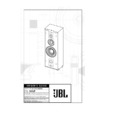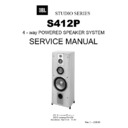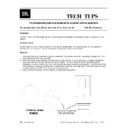JBL S412P STUDIO SERIES (serv.man3) User Manual / Operation Manual ▷ View online
5
RECEIVER/AMPLIFIER
LEFT S412P
RIGHT S412P
LEFT
RIGHT
Y-Connector
(not included)
LFE IN
LFE IN
SUBWOOFER OUT
Each S412P speaker is also
equipped with a line-level
Low-Frequency Effects
(LFE/Subwoofer) input for
superior performance with
digital 5.1 surround
formats. The .1 LFE
channel contains
additional low-frequency
information not found in
the left- and right-front
channels. The LFE input
works with the full-range
speaker-level input to
provide the dynamics and
equipped with a line-level
Low-Frequency Effects
(LFE/Subwoofer) input for
superior performance with
digital 5.1 surround
formats. The .1 LFE
channel contains
additional low-frequency
information not found in
the left- and right-front
channels. The LFE input
works with the full-range
speaker-level input to
provide the dynamics and
effects that your favorite
filmmakers intended.
You will need to use a
Y-Connector (not included)
with one male connector
and two female connectors
to connect the line-level
subwoofer output on your
receiver/amplifier to the
LFE/Subwoofer inputs on
the S412P speakers. Plug
the male connector into
the subwoofer output on
your receiver or amplifier,
and connect each of the
filmmakers intended.
You will need to use a
Y-Connector (not included)
with one male connector
and two female connectors
to connect the line-level
subwoofer output on your
receiver/amplifier to the
LFE/Subwoofer inputs on
the S412P speakers. Plug
the male connector into
the subwoofer output on
your receiver or amplifier,
and connect each of the
two female connectors
to extension RCA patch
cords. Then plug each
patch cord into the
LFE/Subwoofer input of
the left and right S412P
speakers. Note: If your
receiver has separate
left and right line-level
subwoofer (or LFE) output
jacks, you do not need to
use a Y-Connector.
to extension RCA patch
cords. Then plug each
patch cord into the
LFE/Subwoofer input of
the left and right S412P
speakers. Note: If your
receiver has separate
left and right line-level
subwoofer (or LFE) output
jacks, you do not need to
use a Y-Connector.
LINE-LEVEL CONNECTIONS
Studio Series-S412P OM 10/19/99 1:00 PM Page 5
6
AMPLIFIER CONTROLS
LFE Level Control: Allows
you to adjust the volume of
the low-frequency effects/
subwoofer channel to suit
your room acoustics or
tastes. However, it only
affects the LFE signal. If
you are not using the LFE
input, the LFE level control
will not operate.
you to adjust the volume of
the low-frequency effects/
subwoofer channel to suit
your room acoustics or
tastes. However, it only
affects the LFE signal. If
you are not using the LFE
input, the LFE level control
will not operate.
Configuring Your Receiver:
You should choose the
“Large” or “Wide” option
for the left- and right-front
speakers so that full low-
frequency information will
be sent to the S412P
speakers. Make sure that
you also configure your
receiver for “Subwoofer
On” or “LFE On.” In this
case, the LFE/Subwoofer
signal will consist only of
the .1 (bass) channel. The
LFE signal level can be
adjusted by using the
LFE level on the S412P
amplifier panel. For initial
setup, you should set the
level controls on both
speakers at minimum
(full counterclockwise
rotation). With 5.1 source
material playing, advance
the level controls on each
speaker slowly until the
desired amount of effects
channel is present. This
is a rather subjective
adjustment and should be
made using a variety of
program materials.
You should choose the
“Large” or “Wide” option
for the left- and right-front
speakers so that full low-
frequency information will
be sent to the S412P
speakers. Make sure that
you also configure your
receiver for “Subwoofer
On” or “LFE On.” In this
case, the LFE/Subwoofer
signal will consist only of
the .1 (bass) channel. The
LFE signal level can be
adjusted by using the
LFE level on the S412P
amplifier panel. For initial
setup, you should set the
level controls on both
speakers at minimum
(full counterclockwise
rotation). With 5.1 source
material playing, advance
the level controls on each
speaker slowly until the
desired amount of effects
channel is present. This
is a rather subjective
adjustment and should be
made using a variety of
program materials.
If you choose, you can use
the “Small” or “Narrow”
setting on your receiver.
In this case, all of the
information below 80Hz
will be fed to the LFE/
Subwoofer input on the
the “Small” or “Narrow”
setting on your receiver.
In this case, all of the
information below 80Hz
will be fed to the LFE/
Subwoofer input on the
S412P. Now the level
control operates through-
out the entire bass
spectrum below 80Hz, not
just within the .1 channel
portion. This configuration is
generally unnecessary but,
in certain room-placement
conditions, it allows greater
bass-level control.
control operates through-
out the entire bass
spectrum below 80Hz, not
just within the .1 channel
portion. This configuration is
generally unnecessary but,
in certain room-placement
conditions, it allows greater
bass-level control.
Power Switches: The main
“Power” switch is simply
marked “On” and “Off.”
Turn this switch on to
commence operation of
the powered amplifier
after you have plugged the
power cord into an AC
outlet. The second switch
is labeled “On/Off” and
has two positions. Placing
the switch in the “Auto”
position puts the amplifier
in Standby mode. In this
mode the speaker will be
able to automatically
sense an incoming signal,
which will trigger it to turn
fully on. The speaker will
also automatically switch
itself back into Standby
mode after approximately
10 to 15 minutes have
passed without its sensing
a signal. We recommend
that you leave this switch
in the “Auto” position for
most applications. If you
will be away from home or
not using your speakers
for an extended period of
time, you should turn the
speakers off by using the
main power switch. The
Manual position will bypass
the auto-sensing feature
and leave the amplifier on
until turned off with the
main switch or returned to
“Power” switch is simply
marked “On” and “Off.”
Turn this switch on to
commence operation of
the powered amplifier
after you have plugged the
power cord into an AC
outlet. The second switch
is labeled “On/Off” and
has two positions. Placing
the switch in the “Auto”
position puts the amplifier
in Standby mode. In this
mode the speaker will be
able to automatically
sense an incoming signal,
which will trigger it to turn
fully on. The speaker will
also automatically switch
itself back into Standby
mode after approximately
10 to 15 minutes have
passed without its sensing
a signal. We recommend
that you leave this switch
in the “Auto” position for
most applications. If you
will be away from home or
not using your speakers
for an extended period of
time, you should turn the
speakers off by using the
main power switch. The
Manual position will bypass
the auto-sensing feature
and leave the amplifier on
until turned off with the
main switch or returned to
auto sensing by choosing
the auto position.
the auto position.
LED Indicators: When your
speaker is turned on but is
not receiving a signal, the
LEDs glow red to let you
know that your speaker is
plugged in. When the
speaker is receiving a
signal, the LEDs glow
green. We have provided a
convenient “Green ‘On’
LED” switch on the back
panel to allow you to shut
off the front LEDs should
they interfere with your
enjoyment of a movie. This
switch has no effect when
the LEDs are in red mode.
speaker is turned on but is
not receiving a signal, the
LEDs glow red to let you
know that your speaker is
plugged in. When the
speaker is receiving a
signal, the LEDs glow
green. We have provided a
convenient “Green ‘On’
LED” switch on the back
panel to allow you to shut
off the front LEDs should
they interfere with your
enjoyment of a movie. This
switch has no effect when
the LEDs are in red mode.
MANUAL
LFE LEVEL
Min
Max
AUTO
ON
OFF
S 4 1 2 P
L F E I N –
ON
OFF
GREEN “ON”LED
POWER
ON/OFF
CAUTION
RISK OF ELECTRIC SHOCK
DO NOT OPEN
“WARNING: TO REDUCE THE RISK OF FIRE OR ELECTRIC SHOCK,
DO NOT EXPOSE THIS APPLIANCE TO RAIN OR MOISTURE.”
“AVERTISSEMENT: POUR PRÉVENIR LES RISQUES D’INCENDIE OU
DE CHOC ELECTRIQUE, EVITER D’EXPOSER CET APPAREIL A LA
PLUIE OU A L’HUMIDITE.”
DO NOT EXPOSE THIS APPLIANCE TO RAIN OR MOISTURE.”
“AVERTISSEMENT: POUR PRÉVENIR LES RISQUES D’INCENDIE OU
DE CHOC ELECTRIQUE, EVITER D’EXPOSER CET APPAREIL A LA
PLUIE OU A L’HUMIDITE.”
This area is designed to become quite warm
during normal operation.
Studio Series-S412P OM 10/19/99 1:00 PM Page 6
7
T R O U B L E S H O O T I N G
If there is no sound from
any of the speakers:
any of the speakers:
• Check that receiver/
amplifier is on and that a
source is playing.
amplifier is on and that a
source is playing.
• Review proper operation
of your receiver/amplifier.
of your receiver/amplifier.
If there is no sound coming
from one speaker:
from one speaker:
• Check the “Balance”
control on your
receiver/amplifier.
control on your
receiver/amplifier.
• Check all wires and
connections between
receiver/amplifier
and speakers.
connections between
receiver/amplifier
and speakers.
• Make sure all wires are
connected. Make sure
none of the speaker wires
are frayed, cut or
punctured.
connected. Make sure
none of the speaker wires
are frayed, cut or
punctured.
If the system plays at low
volumes but shuts off as
volume is increased:
volumes but shuts off as
volume is increased:
• Check all wires and
connections between
receiver/amplifier
and speakers.
connections between
receiver/amplifier
and speakers.
• Make sure all wires are
connected. Make sure
none of the speaker
wires are frayed, cut or
punctured.
connected. Make sure
none of the speaker
wires are frayed, cut or
punctured.
• If more than one pair of
main speakers is being
used, check the minimum
impedance requirements of
your receiver/amplifier.
main speakers is being
used, check the minimum
impedance requirements of
your receiver/amplifier.
If there is no (or low) bass
output:
output:
• Make sure the polarities
(+ and –) of the left and
right “Speaker Inputs” are
connected properly.
(+ and –) of the left and
right “Speaker Inputs” are
connected properly.
• Make sure that the
speaker is plugged into an
active electrical outlet and
switched on, and that the
green LEDs are displayed.
speaker is plugged into an
active electrical outlet and
switched on, and that the
green LEDs are displayed.
If you used the LFE input
and there is no sound from
the subwoofer:
and there is no sound from
the subwoofer:
• Check that receiver/
amplifier is on and that a
source is playing.
amplifier is on and that a
source is playing.
• Make sure that the
speaker is plugged into an
active electrical outlet.
speaker is plugged into an
active electrical outlet.
• Check all wires and
connections between
receiver/amplifier and
speakers.
connections between
receiver/amplifier and
speakers.
• Make sure all wires are
connected. Review the
“Line-Level Connections”
section on page 5 of this
manual and make sure that
a single RCA patch cord
is connected to each
loudspeaker from the
Y-Connector plugged into
the receiver/amplifier’s
subwoofer output. Make
sure none of the speaker
wires are frayed, cut or
punctured.
connected. Review the
“Line-Level Connections”
section on page 5 of this
manual and make sure that
a single RCA patch cord
is connected to each
loudspeaker from the
Y-Connector plugged into
the receiver/amplifier’s
subwoofer output. Make
sure none of the speaker
wires are frayed, cut or
punctured.
• Review proper operation
of your receiver/amplifier,
including making sure that
you have configured your
receiver so that the sub-
woofer output is active.
of your receiver/amplifier,
including making sure that
you have configured your
receiver so that the sub-
woofer output is active.
If you are using the S412P
LFE/Subwoofer input and
the bass level decreases
(instead of increasing)
when you turn the LFE/
Subwoofer Level knob
clockwise:
LFE/Subwoofer input and
the bass level decreases
(instead of increasing)
when you turn the LFE/
Subwoofer Level knob
clockwise:
• Recheck to make sure
that your receiver or
amplifier-speaker outputs
are correctly connected to
the S412P speaker inputs
(gold-plated binding posts),
(+) to (+) and (–) to (–). The
S412P (+) terminal has a red
stripe and is located on the
right-hand side, below the
letter “L” of the molded JBL
logo, when looking directly at
the back of the S412P.
that your receiver or
amplifier-speaker outputs
are correctly connected to
the S412P speaker inputs
(gold-plated binding posts),
(+) to (+) and (–) to (–). The
S412P (+) terminal has a red
stripe and is located on the
right-hand side, below the
letter “L” of the molded JBL
logo, when looking directly at
the back of the S412P.
• If the wires are connected
properly, the confusion may
be attributable to the design
of your receiver/ amplifier.
Your unit may have inverting
inputs, which reverse the
polarity of the signal
between the inputs and
outputs of the amplifier. To
check if this is the case,
reverse the speaker con-
nections for ALL S412Ps in
your system (and disconnect
any other speakers in the
system) so that the
receiver/amplifier’s (+)
connector is connected to
each S412P’s (–) (black
stripe) speaker connector.
If you do this and the
S412Ps function properly
(bass increases as you turn
your LFE/Subwoofer level-
control knobs clockwise),
your receiver/amp uses
inverting inputs. This is not
a problem. Simply connect
all of the speakers in your
system the same way, with
the receiver or amplifier’s
(+) terminal to the speaker’s
(–) terminal, and the receiver
or amplifier’s (–) terminal to
the speaker’s (+) terminal.
properly, the confusion may
be attributable to the design
of your receiver/ amplifier.
Your unit may have inverting
inputs, which reverse the
polarity of the signal
between the inputs and
outputs of the amplifier. To
check if this is the case,
reverse the speaker con-
nections for ALL S412Ps in
your system (and disconnect
any other speakers in the
system) so that the
receiver/amplifier’s (+)
connector is connected to
each S412P’s (–) (black
stripe) speaker connector.
If you do this and the
S412Ps function properly
(bass increases as you turn
your LFE/Subwoofer level-
control knobs clockwise),
your receiver/amp uses
inverting inputs. This is not
a problem. Simply connect
all of the speakers in your
system the same way, with
the receiver or amplifier’s
(+) terminal to the speaker’s
(–) terminal, and the receiver
or amplifier’s (–) terminal to
the speaker’s (+) terminal.
Studio Series-S412P OM 10/19/99 1:00 PM Page 7
JBL Consumer Products
250 Crossways Park Drive, Woodbury, NY 11797
800-336-4JBL (4525) (USA only)
www.jbl.com
©1999 JBL, Incorporated.
JBL is a registered trademark of JBL, Incorporated.
Part No. S412P O/G
T W E E T E R T Y P E : Pure-titanium dome with EOS™ waveguide
D E S I G N G O A L : Bring the thrill of live performance and movie sound to
the home environment by calling on JBL’s professional engineering leadership.
the home environment by calling on JBL’s professional engineering leadership.
C R O S S O V E R N E T W O R K : Straight-Line Signal Path™ (SSP)
W O O F E R T Y P E : Cast-aluminum basket with HeatScape™ motor structure
P O R T D E S I G N : FreeFlow™ flared
P R O F E S S I O N A L R E F E R E N C E : Studio Monitor
O W N E R ’ S G U I D E
P R O S O U N D
C O M E S H O M E
C O M E S H O M E
™
P R O D U C T L I N E :
STUDIO SERIES
M O D E L
S412P
N U M B E R :
S P E C I F I C A T I O N S
Maximum Recommended Amplifier Power*: 250W
Powered Subwoofer Amplifier Output: 200W
Nominal Impedance: 8 Ohms
Sensitivity (2.83V/1m): 91dB
Frequency Response (–3dB): 32Hz – 20kHz
Crossover Frequencies: 200Hz, 850Hz, 3500Hz
High-Frequency Transducer: 1" Pure-titanium dome
Midrange Transducer: 4" PolyPlas™ cone
Midbass Transducer: 6" PolyPlas™ cone
Low-Frequency Transducer: 12" PolyPlas™ cone
Dimensions (H x W x D): 44" x 16" x 13-3/8" (1118mm x 406mm x 340mm)
Weight (per speaker): 86 lb (39.1 kg)
*The maximum recommended amplifier power rating will ensure proper system headroom to
allow for occasional peaks. We do not recommend sustained operation at these maximum
power levels.
Occasional refinements may be made to existing products without notice but will always meet
or exceed original specifications, unless otherwise stated.
**Trademark of Dolby Laboratories.
DTS is a registered trademark of Digital Theater Systems, Inc.
S412P
Studio Series-S412P OM 10/19/99 1:00 PM Page 8
Display



